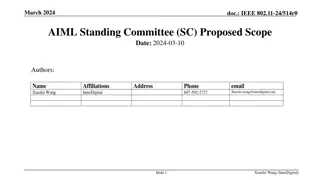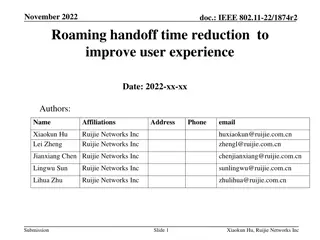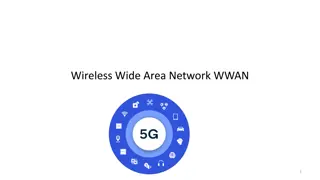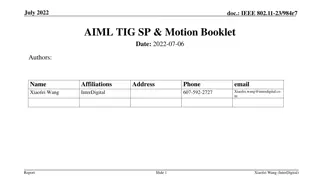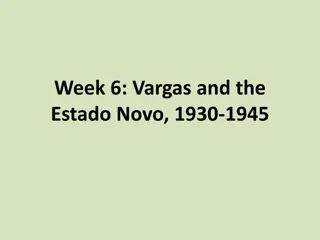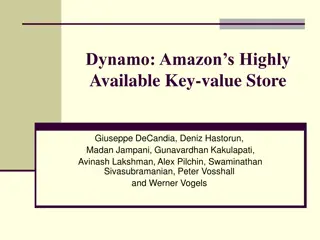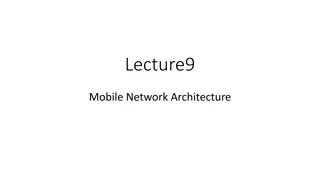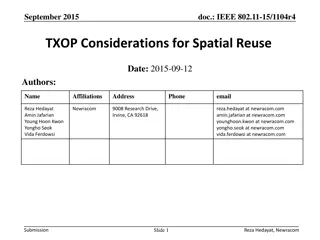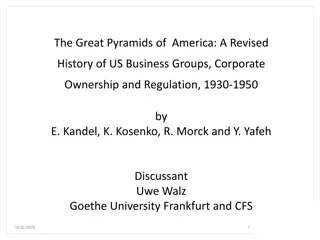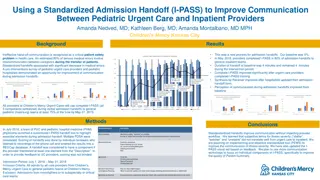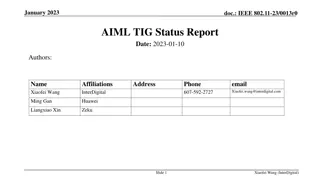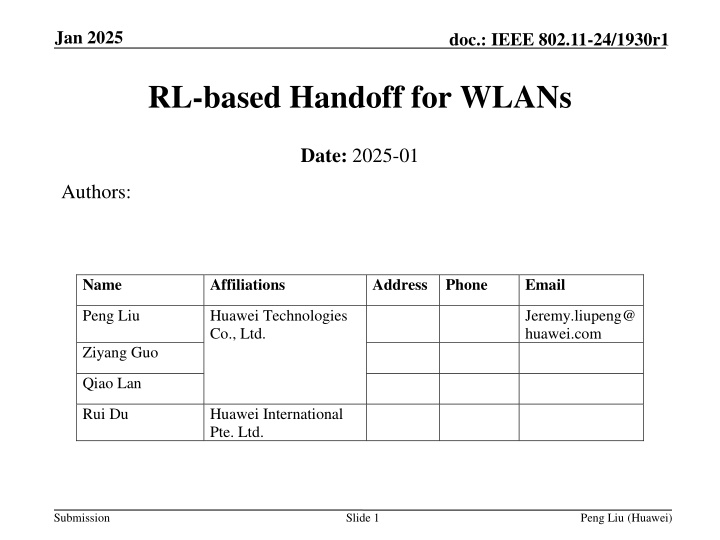
Efficient Reinforcement Learning-based Handoff for WLANs
Explore how RL-based handoff optimizes WLAN procedures by learning long-term rewards and interactions with the environment, overcoming challenges faced by traditional RSSI-based algorithms in WLAN handoff optimization.
Download Presentation

Please find below an Image/Link to download the presentation.
The content on the website is provided AS IS for your information and personal use only. It may not be sold, licensed, or shared on other websites without obtaining consent from the author. If you encounter any issues during the download, it is possible that the publisher has removed the file from their server.
You are allowed to download the files provided on this website for personal or commercial use, subject to the condition that they are used lawfully. All files are the property of their respective owners.
The content on the website is provided AS IS for your information and personal use only. It may not be sold, licensed, or shared on other websites without obtaining consent from the author.
E N D
Presentation Transcript
Jan 2025 doc.: IEEE 802.11-24/1930r1 RL-based Handoff for WLANs Date: 2025-01 Authors: Name Affiliations Address Phone Email Peng Liu Huawei Technologies Co., Ltd. Jeremy.liupeng@ huawei.com Ziyang Guo Qiao Lan Rui Du Huawei International Pte. Ltd. Submission Slide 1 Peng Liu (Huawei)
Jan 2025 doc.: IEEE 802.11-24/1930r1 Abstract In this contribution, we introduce RL (reinforcement learning) based handoff for WLANs, discuss the signalling/interworks to facilitate the handoff procedure. Submission Slide 2 Peng Liu (Huawei)
Jan 2025 doc.: IEEE 802.11-24/1930r1 Introduction Due to the mobility of STAs, handoff is a key procedure in WLANs. To associate with a better AP, a STA will initially broadcast a probe request on candidate channels. APs operating on these candidate channels may respond to the STA. Once the STA receives responses, it will select one AP from all the APs that have responded. Typical handoff algorithm is RSSI-based. It usually relies on two thresholds: the scanRSSI and the targetRSSI. When the RSSI of the current associated AP falls below the scanRSSI threshold, a STA will initiate the scanning procedure by sending a probe request. Upon receiving responses, the STA will select the AP with the highest RSSI from among those whose RSSIs are greater than the targetRSSI. AP1 AP2 (target AP) STA Submission Slide 3 Peng Liu (Huawei)
Jan 2025 doc.: IEEE 802.11-24/1930r1 Introduction (Cont.) The RSSI-based algorithm faces the challenge of selecting an appropriate scanRSSI value. For instance, a high scanRSSI may result in unnecessary power consumption for scanning, while a low scanRSSI may cause the STA to miss the best opportunity to associate with a better AP. Different candidate APs may lead to different switch points due to network topologies. RSSI does not fully reflect the quality of APs. Switch point AP1 Rate AP1 Candidate APs AP2 Rate AP2 AP2 RSSI AP1 RSSI AP1 -30m 0m Submission Slide 4 Peng Liu (Huawei)
Jan 2025 doc.: IEEE 802.11-24/1930r1 Preliminary Reinforcement Learning: learn the policy that maximizes a long-term reward via interaction with the environment State: ??, Action: ??, Reward: ?? Long-term reward: ?=0 Policy: (?): ?? ??, parameterized by ? Learn the policy is to learn the model parameters ? ????+?+1,? 0,1 State can be observations from MAC/PHY, e.g., radio measurement, historical statistics, etc. Action can be a MAC decision, e.g., channel access parameter, power control, etc. Reward can be a metric in terms of throughput, delay RL is an efficient AI tool for solving decision-making problems such as channel access, power control, etc. Training data for RL: S?,??,??+1,??+1,??+1,??+2 Submission Slide 5 Peng Liu (Huawei)
Jan 2025 doc.: IEEE 802.11-24/1930r1 Framework of RL based Handoff ?: observations, may include the observation from current AP (rate, per, channel load, rssi), the RSSI of candidate APs, and the historical information of candidate APs (historical rates, delay, ). a: action, may include no switch, switch to candidate AP2, switch to candidate AP3 R: reward, could be any metric that represents the quality of the target AP ? Update ? Handoff procedure can be regarded as a decision-making problem, which is solved by RL algorithm. The handoff policy ? ? can be regarded as a likelihood of switching to an AP given observation ?. The model ? can be iteratively updated based on the training data (?,?,?), and finally converges to the best point. Submission Slide 6 Peng Liu (Huawei)
Jan 2025 doc.: IEEE 802.11-24/1930r1 Signaling for RL-based Handoff (Opt #1) AP1 STA AP2 Handoff decision is based on the AI model, which is trained at the AP side and shared to the STA. At every handoff event, the STA calculates the likelihood of switching to the candidate AP and makes a handoff decision. Optionally, the AP can collect the training data and update the model after the event. The model can be updated via any RL algorithm. The reward can be any metric related to rate, delay, quality of experience, etc. Given the model, an appropriate scanRSSI can be chosen such that the model outputs a desired likelihood. AP1 RSSI < scanRSSI Probe request Probe response ?(?) observations hand off Calculate reward reward Update Model ?, scanRSSI Submission Peng Liu (Huawei) Slide 7
Jan 2025 doc.: IEEE 802.11-24/1930r1 Signaling for RL-based Handoff (Opt #2) AP1 STA AP2 Opt #2 is a simplified version, where STA uses RSSI-based handoff algorithm with a scanRSSI suggested by the AI model. In this case , the observations of the model only contain RSSIs of current AP and candidate APs. Opt #2 does not require model sharing, but is more sensitive to the variance of RSSIs. In practice, Opt #1 and Opt #2 could be selected according to the capability of STAs. AP1 RSSI < scanRSSI Probe request Probe response RSSI-based handoff decision AP 1 RSSI, AP 2 RSSI hand off Calculate reward reward Update Model scanRSSI Submission Peng Liu (Huawei) Slide 8
Jan 2025 doc.: IEEE 802.11-24/1930r1 Summary In this contribution, we introduced a RL-based handoff framework. We provide two interworking options to assist the handoff of STAs. To facilitate the benefit of RL-based handoff, reward exchange between APs is required. Submission Slide 9 Peng Liu (Huawei)


